Can Raspberry Pi 5 be used with anything other than a 5V/5A compatible power adapter? I compared the stability under high load with a genuine power supply and a non-genuine power supply.

For Raspberry Pi 4, it was recommended to use a power adapter that can supply 5V/3A power, but for
Raspberry Pi 5 – Raspberry Pi
https://www.raspberrypi.com/products/raspberry-pi-5/
Raspberry Pi 27W USB-C Power Supply – Raspberry Pi
https://www.raspberrypi.com/products/27w-power-supply/
Raspberry Pi Documentation - Raspberry Pi 5
https://www.raspberrypi.com/documentation/computers/raspberry-pi-5.html
·table of contents
◆1: Preface about technical aptitude
◆2: Equipment used for verification
◆3: Applying high load when using the genuine power adapter
◆4: Applying high load when using a non-genuine power adapter
◆5: Request 5A output from non-genuine power adapter and apply high load
◆6: Request 5V/5A from non-genuine power adapter with PPS and apply high load
◆7: Check if the genuine power adapter can really output 5V/5A
◆8: Summary
◆1: Preface about technical aptitude
The Raspberry Pi 5 used this time was sent directly to the GIGAZINE editorial department from the Raspberry Pi Foundation and has not received technical standards compliance certification. Therefore, we have submitted a notification for the ` `special system for experiments, etc. using equipment that has not obtained technical compliance .'' In addition, in Japan, Raspberry Pi 5 is scheduled to be released after the technical compliance application by the agency, so general users do not need to worry about technical compliance.

◆2: Equipment used for verification
The Raspberry Pi Foundation's genuine power adapter 'Raspberry Pi 27W USB-C Power Supply' is below. The cable and adapter are integrated to avoid using underperforming cables.

If you look at the compatible output column, you can see that it can output at '5.1V/5.0A'.

This time, we prepared Adtech's '

Looking at the compatible output column, you can see that it is possible to output at '5V/3A' and that 5V/5A is included within the PPS range.

The operation verification environment looks like this. In order to verify the operation when power is output from the USB port of Raspberry Pi 5, connect an external SSD and load device '

The load current of the load device was set to 1.6A, which is the maximum output of Raspberry Pi 5. Furthermore, I installed the software ``stress'' on Raspberry Pi 5, which puts a load on the system. In this environment, 'CPU and USB port are both unloaded', 'stress -c 4' command makes all CPU cores 100% used, and from the USB port 'load device 1.6A' and 'SSD Check the output status from the power adapter and the USB port when the standby current is being output.

◆3: Applying high load when using the genuine power adapter
First, check the output from the power adapter and the output from the USB port when the genuine power adapter is connected.

Under no load, the power adapter output was 5.1346V/0.8200A.

Also, the output voltage from the USB port was 5.001V.

The execution results of the command 'vcgencmd pmic_read_adc' that can check the power consumption of the system from PMIC are as follows.

Next, when I put a load on the CPU and USB port, the output from the power adapter became 5.1863V/3.0378A.
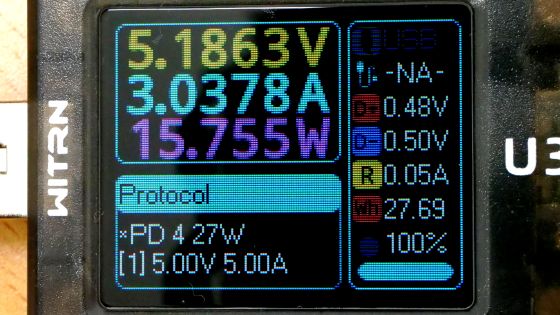
The output voltage from the USB port is 4.597V. There is no sign that the system is particularly unstable.
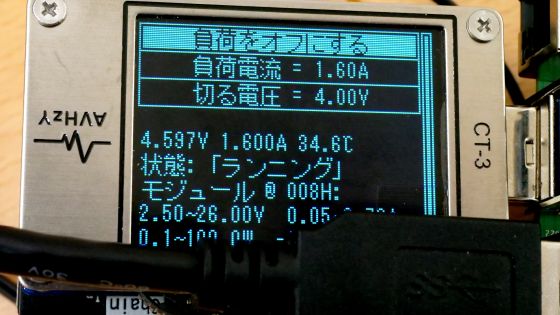
The execution results of 'vcgencmd pmic_read_adc' are as follows.

◆4: Applying high load when using a non-genuine power adapter
Next, check the output from the power adapter and the output from the USB port when a non-genuine power adapter is connected.

The system will start even if you connect a non-genuine power adapter, but a notification will appear in the upper right corner of the screen stating that ``The power supply to peripheral devices will be limited because the current is below 5A.'' However, various software will work without problems even in this state.

The output from the power adapter under no load is 5.1338V/0.8147A.

The output from the USB port was 4.964V.

Next, try putting a load on the CPU and USB port.
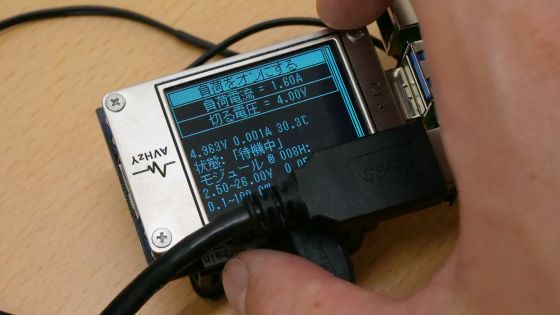
As a result of applying a load to the USB port, the output voltage dropped below 4V. When you play the movie below, you can see that the output voltage is below 4V and the safety function of the load device is activated.
Also, when applying a load to the USB port, warnings for 'low voltage' and 'excessive USB output' were displayed at the top right of the screen.

◆5: Request 5A output from non-genuine power adapter and apply high load
The power adapter 'APD-V140AC2-BK' used for verification this time includes 5V/5A in the PPS range, so theoretically it should be possible to output at 5V/5A. When I checked the official Raspberry Pi forum, the Raspberry Pi developer posted , ``If you add 'PSU_MAX_CURRENT=5000' to the EEPROM configuration file, you can skip the USB-PD compatible output inquiry process and request 5A output.'' So I decided to try it.
The steps to rewrite the EEPROM settings are as follows. First, run the following command:
[code]sudo rpi-eeprom-config -e[/code]
This will open the EEPROM configuration file, so add the line 'PSU_MAX_CURRENT=5000' and save it.

After that, restart the system and the EEPROM will be rewritten. When I checked the serial console, it said 'max-current 5000'. You should now be able to request 5A output from your non-genuine power adapter.

I requested 5A output from the non-genuine power adapter, and the output from the power adapter was 5.1041V/0.9744A with no load on the CPU and USB port.
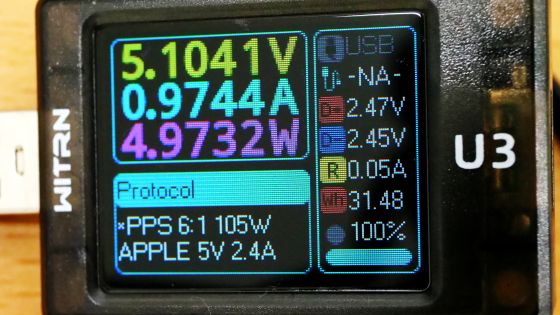
The output from the USB port is 4.934V.
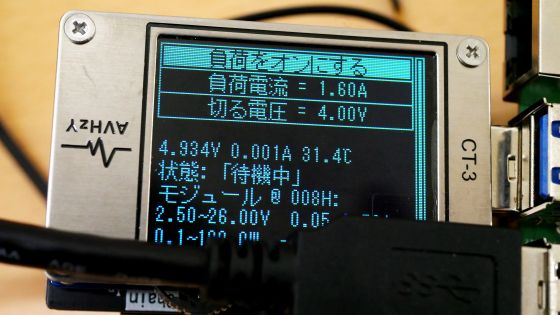
Next, when I put a load on the CPU and USB port, the output from the power adapter became 4.9490V/2.6094A.

The output voltage from the USB port is 4.376V, well below 5V. When no settings were made, there was no output at high loads, so it can be said that this is an improvement, but it was confirmed that the output was smaller than the original power supply.
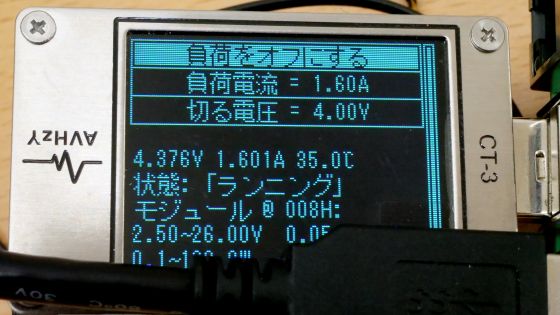
◆6: Request 5V/5A from non-genuine power adapter with PPS and apply high load
The USB tester 'WITRN U3' used this time is equipped with a function that allows you to explicitly specify the output voltage and power for a USB-PD compatible power supply. Therefore, I decided to check the operation when requesting 5.1V/5A output from APD-V140AC2-BK.
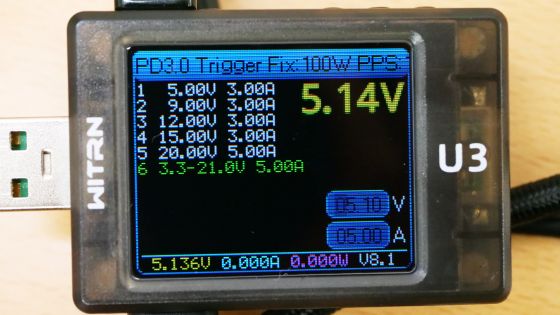
When requesting 5.1V/5A output and no load on the CPU and USB port, the output from the power adapter was 4.8106V/1.9431A.

The output voltage from the USB port was 4.952V.
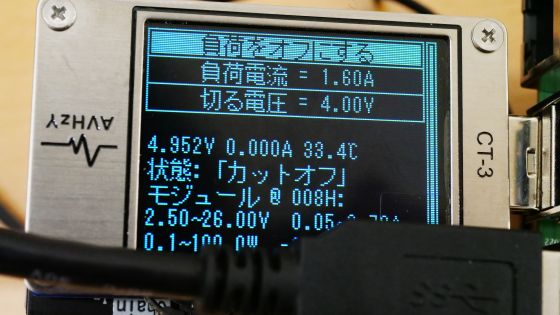
Next, I tried putting a load on the CPU and USB port, but the power turned off the moment I put a load on the USB port.
In addition, we conducted a similar verification using the power adapter '

◆7: Check if the genuine power adapter can really output 5V/5A
Finally, in order to confirm whether the genuine power adapter really supports output at 5V/5A, I connected a load device to the genuine power adapter and applied a load.

As a result of verification, it was found that an output of 5.233V/5.000A is possible.
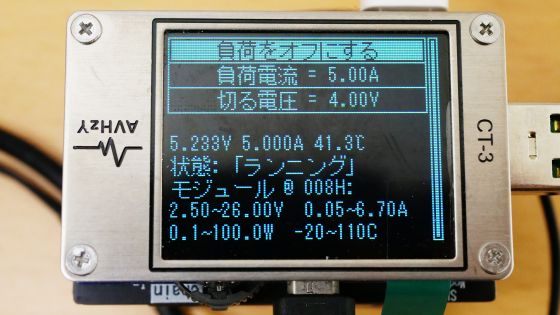
◆8: Summary
As a result of verifying the operation of a genuine power adapter that supports output at 5V/5A and a non-genuine power adapter that supports output at 5V/3A, we found that a power adapter that only supports output at 5V/3A does not load the USB port. It was found that the system became unstable when For applications that do not place a large load on the USB port, you can use a power adapter that does not support 5V/5A without any problems, but if you plan to connect a large number of devices to the USB port, use a power adapter that supports 5V/5A. You should prepare it.
◆Forum now open
GIGAZINE's official Discord server has a forum related to Raspberry Pi 5. Anyone can write from the link below, so please write something like 'I'm curious about ○○'.
• Discord | 'Raspberry Pi 5 has arrived at the GIGAZINE editorial department, so I'm going to review it, but what do you want to know? ' | GIGAZINE
https://discord.com/channels/1037961069903216680/1166304963497041981

Related Posts:







